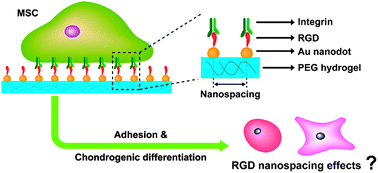Effects of RGD nanospacing on chondrogenic differentiation of mesenchymal stem cells†
Abstract
Modification of material surfaces by an arginine-glycine-aspartate (RGD) peptide, a ligand of transmembrane integrin, can regulate cell adhesion and other events in tissue engineering and regenerative medicine. While both RGD effects and chondrogenesis are very important and have been much reported, the studies on the influence of the spatial arrangement of RGD ligands on chondrogenic differentiation are rather limited. Herein, we examined the effects of RGD nanospacing on in vitro two-dimensional chondrogenic differentiation of mesenchymal stem cells (MSCs) for the first time. Using a unique nanolithography technology, hexagonal RGD nanopatterns were generated on nonfouling poly(ethylene glycol) (PEG) hydrogels. Two nanospacings (63 and 161 nm) were achieved, with one below and the other above the critical nanospacing. After one-day incubation and nine-day chondrogenic induction, expressions of collagen II proteins and chondrocyte-specific genes (SOX9, aggrecan and collagen II) were detected. The statistics illustrated that the large nanospacing led to a less spreading area and a higher chondrogenic differentiation extent. Further tests by the addition of an inhibitor SB203580 confirmed the positive regulation of the p38 phospho-relay cascade on the chondrogenic induction in this model system.


 Please wait while we load your content...
Please wait while we load your content...